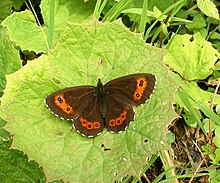| Erebia | |
|---|---|

| |
| Arran brown (type species) | |
| Scientific classification | |
| Domain: | Eukaryota |
| Kingdom: | Animalia |
| Phylum: | Arthropoda |
| Class: | Insecta |
| Order: | Lepidoptera |
| Family: | Nymphalidae |
| Subtribe: | Erebiina |
| Genus: | Erebia Dalman, 1816 |
| Type species | |
| Papilio ligea Linnaeus, 1758
| |
| Diversity | |
| Around 100 species | |
| Synonyms | |
|
Atercoloratus Bang-Haas, 1938 | |






Erebia is a Holarctic genus of brush-footed butterflies, family Nymphalidae. Most of the about 90–100 species (see also below) are dark brown or black in color, with reddish-brown to orange or more rarely yellowish wing blotches or bands. These usually bear black spots within, which sometimes have white center spots.
This genus has found it easy to adapt to arid and especially cold conditions. Most of its members are associated with high-altitude lands, forest clearings or high latitude and tundra. Erebia species are frequent in the Alps, Rocky Mountains, subarctic and even Arctic regions, and the cooler parts of Central Asia. In fact, the North American term for these butterflies is alpines. Palearctic species are collectively known as ringlets or arguses. However, none of these terms is used exclusively for this genus.